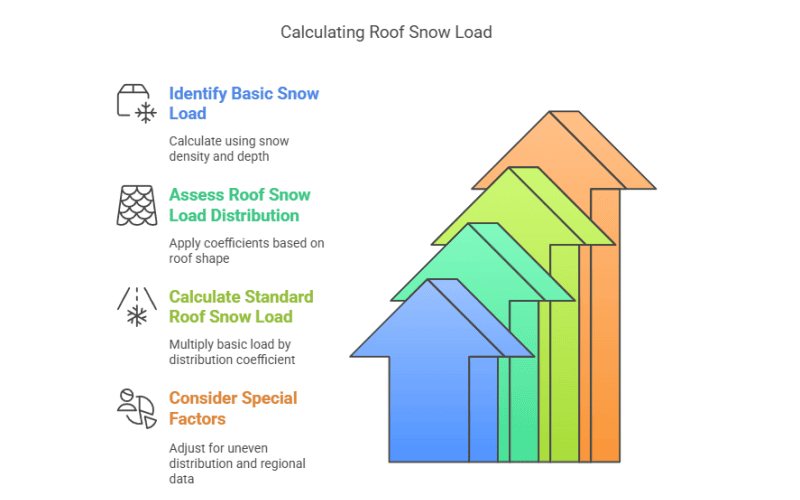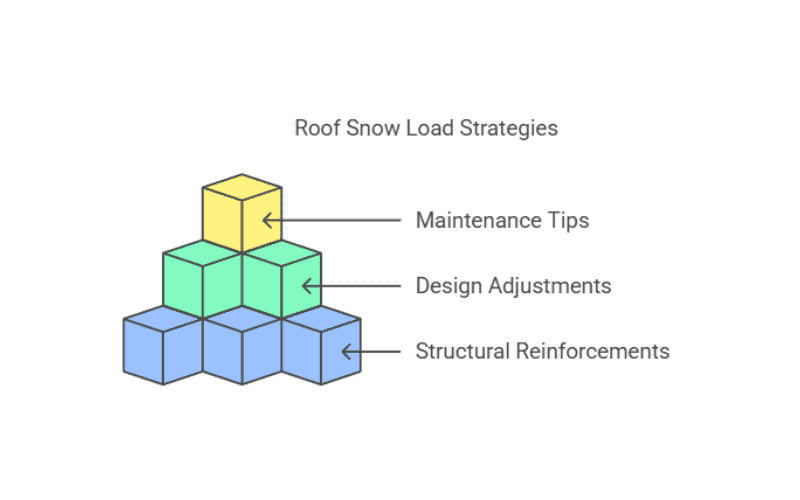If you’ve ever had to cope with substantial snowfall, you’re aware of how taxing it can be on your building. From roofs sagging under the weight to potential structural damage, snow load is a quiet but serious threat to your property’s longevity. For those living in snowy regions, understanding how snow load affects steel structures isn’t just a nice-to-know—it’s a must. In this article, we’ll walk you through everything you need to know about snow load, from choosing the best roof pitch for heavy snow to practical tips for strengthening your building. Whether you’re building new or reinforcing an existing structure, we’ve got your back.
What is a Snow Load?
Snow load might sound like a technical term, but it’s simply the weight of snow that accumulates on your roof. The heavier the snow, the greater the pressure on your structure. Factors like snow density, temperature fluctuations, and wind can all influence how much load your roof has to bear. For example, wet snow is significantly heavier than dry, fluffy snow, and a sudden thaw can add even more stress as the snow melts and refreezes.
How Snow Load Affects Your Roof
Indeed, your roof serves as the primary shield against snow, yet it is simultaneously the most susceptible component. Accumulation of excessive snow can result in roof deformation, leaks, or, in worst-case scenarios, even collapse. Over time, the constant pressure can cause fatigue in steel structures, shortening the lifespan of your building. This is why understanding your region’s snow load requirements is crucial. For instance, areas like the Rocky Mountains or the Northeast U.S. have higher snow load standards compared to milder climates.
What other impacts can snow load have on your house:
- Steel Fatigue: Continuous snow load can stress steel structures, weakening them over time.
- Shorter Building Lifespan: The constant pressure from snow can reduce the overall durability of the structure.
- Increased Maintenance Costs: Roofs burdened by substantial snow might necessitate frequent repairs and upkeep.
- Load Redistribution: Uneven snow distribution can cause additional stress on weak spots of the roof.
Are you interested in learning about other kinds of forces acting on steel structures? Read our article: Understanding Loads on Steel Structures: Types, Calculations and Design Key Points
How to Calculate Roof Snow Load for Steel Structure Buildings
To calculate roof snow load for steel structures, follow these steps:

1. Find the Basic Snow Load
The basic snow load (S₀) is calculated using snow data for open, flat areas, typically the maximum snow load expected in 50 years. This figure is determined by snow thickness and snow compactness. The formula is:
S₀ = γ × d
Where:
- S₀ is the basic snow load (kN/m²)
- γ is the snow density (kN/m³)
- d is the snow depth (m)
Example 1: Suppose you are in a region where the snow density (γ) is 0.5 kN/m³, and the snow depth (d) is 0.3 meters. The basic snow load (S₀) would be calculated as:
S₀ = 0.5 × 0.3 = 0.15 kN/m²
2. Assess the Roof Snow Load Distribution
Snow load can differ based on the shape and slope of the roof. A roof with a steep slope will accumulate snow differently than a flat one. You need to apply a roof snow load distribution coefficient (Cₛ), which is typically found in local building codes.
For example, a flat roof may have a coefficient of 1.0, while a sloped roof may have a coefficient of 0.7.
Example 2: Let’s say the distribution coefficient (μᵣ) for your roof type is 0.8, and you’ve already calculated the basic snow load (S₀) as 0.15 kN/m². To calculate the snow load on the roof, use the formula:
Sᵏ = μᵣ × S₀
Sᵏ = 0.8 × 0.15 = 0.12 kN/m²
This means the snow load on the roof, after accounting for its shape and slope, is 0.12 kN/m².
3. Calculate the Standard Roof Snow Load
The standard roof snow load is calculated by multiplying the basic snow load (S₀) by the snow load distribution coefficient (μᵣ). You’ve already done this in Example 2, where:
Sᵏ = μᵣ × S₀
This will give you the snow load on the roof’s horizontal projection, which is a key value for assessing the roof’s ability to bear snow.
Special Considerations
- Uneven Snow Distribution: If your roof has multiple levels, parapets, or overhanging eaves, snow may accumulate unevenly. You must apply special coefficients to account for this.
- Regional Adjustments: In areas with heavy snow, you might need to adjust the snow load based on local snowpack data, or use more detailed weather reports.
- Other Factors: Some standards include additional coefficients for factors like thermal effects, slope, and exposure to wind, which could influence snow load.
Best Roof Pitch for Heavy Snow Load
When it comes to handling snow, the shape of your roof matters. A more inclined roof slope facilitates the shedding of snow, decreasing the likelihood of accumulation. For heavy snow regions, we recommend a pitch between 30° and 45°. This angle strikes a balance between shedding snow and maintaining structural stability.
- Why Pitch Matters: A low-pitched roof might look sleek, but it’s a magnet for snow buildup. On the other hand, a steep pitch can be more expensive to construct but pays off in the long run by minimizing maintenance and repair costs.
- Material Considerations: Steel roofs with a steeper pitch often require additional bracing to handle the increased wind load, but the trade-off is worth it for the added durability.
For Milder Snow Regions
In areas with less snow or where snow load is not a significant concern, a roof pitch of 15° to 25° is typically sufficient. This is an optimal angle for rainwater runoff and can provide cost-effective construction while still maintaining decent snow shedding capability.
- Why a Moderate Pitch Works: A moderate roof pitch ensures rain and light snow runoff without unnecessary structural complexity or increased costs.
- Material Considerations: In these regions, the focus is more on durability and weather resistance than snow shedding. Steel roofing can be used without the need for heavy bracing, keeping costs down.
By considering both the region’s snow load and roof pitch, you can ensure a balanced approach that optimizes the roof’s ability to handle environmental conditions while managing construction and long-term maintenance costs effectively.
Steel Structure Metal Carport Snow Load: A Special Case
Steel Structure metal carports are a popular choice for their affordability and durability, but they’re not immune to snow load challenges. Without adequate design, a significant snowfall can result in the roof deflecting or even failing. Here’s how we tackle this issue:
- Reinforced Framing: Use additional support beams and cross-bracing to distribute the snow load more evenly. For areas with heavy snow, increase the number and size of vertical support columns to handle greater weight.
- High-Strength Steel: Opt for high-strength, corrosion-resistant steel, such as ASTM A992 or A572, to ensure that the frame can handle snow pressure without bending or breaking. Consider using thicker gauge steel for the roof frame.
- Roof Pitch: For regions with significant snowfall, increase the roof pitch to at least 25° to encourage snow shedding. This helps prevent accumulation and reduces the load on the structure.
One of our clients in Minnesota had a metal carport that survived a record-breaking snowfall last winter, thanks to these design enhancements.
How to Increase Snow Load Capacity on Your Roof
Worried about your roof handling heavy snow? Don’t stress—there are a few easy ways to boost its snow load capacity and keep everything safe through the winter:

Structural Reinforcements
- Add Support Beams: Adding extra beams or steel trusses across your roof helps spread the snow’s weight more evenly. If your roof is large, try bringing the support columns closer together (say, every 3 meters instead of 5). It’ll make your roof a lot stronger without much hassle.
- Upgrade Materials: Choose high-strength steel like ASTM A992 or A572. These varieties of steel possess sufficient strength to withstand significant snow loads without deflecting. And don’t forget about galvanized steel—it’s great for protecting against snow and moisture over time.
Design Adjustments
- Increase Roof Pitch: A steeper roof pitch (around 25° to 35°) helps snow slide off naturally, so it doesn’t pile up. This is particularly advantageous in regions that experience heavy snowfall. A little slope goes a long way in preventing snow buildup and keeping your roof safe.
- Install Snow Guards: Snow guards are simple but effective. They keep snow from sliding off too quickly and damaging your roof or anything below. Heavy-duty aluminum or stainless steel snow guards are a solid choice for handling large amounts of snow.
Maintenance Tips
- Regular Snow Removal: After each heavy snowfall, clear the snow off the roof to prevent excessive load buildup. Employ a snow rake or engage a professional to safely eliminate snow, particularly when it accumulates to more than 6 inches.
- Routine Inspections: It’s always a good idea to check the roof for signs of stress after a big storm. Look out for any bending or cracking in the steel. If anything’s off, it’s better to reinforce it sooner than later.
Our Expertise as a Prefab Steel Structure Manufacturer
Snow load can significantly impact the safety of a building and even pose risks to personal safety. That is the reason we concentrate on personalized designs that are adapted to the particular requirements of your area. Whether it’s a residential home, a commercial building, a Light Steel Structure Workshop, or a metal carport, we use high-quality materials and advanced engineering to ensure your structure is ready to withstand whatever winter brings.
- Regional Adaptability: We analyze local climate data to design buildings that meet or exceed snow load requirements.
- Proactive Solutions: From reinforced framing to optimized roof pitches, we build with durability in mind.
Snow load is more than just a seasonal nuisance—it’s a critical factor in the longevity and safety of your building. By comprehending how it influences steel structures and implementing preemptive measures to lessen its effects, you can guarantee that your property remains resilient for many years ahead. At Steelpro PEB, our expertise lies in designing steel structures that are both durable and dependable. If you’re in a snowy region and need a building that can handle the weight of winter, let’s talk. Together, we can build something that lasts.

